The Influence of Typhoon-Induced Wave on the Mesoscale Eddy
Abstract
:1. Introduction
2. Materials and Methods
2.1. Typhoon Cases
2.2. Settings of the FVCOM-SWAVE
2.3. Stokes Drift
2.4. Mesoscale Eddy Identification
- The components of the current speed u and v on both sides of the eddy center have opposite signs and their absolute value increases with movement away from the center;
- The minimum velocity point within the selected range is defined as the eddy center; and
- The direction of the two adjacent velocity vectors around the eddy center has to be close to each other, which is located in the same or adjacent quadrants, to ensure the same direction of rotation.
3. Results
3.1. Validation of FVCOM-SWAVE Hindcast Results
3.2. Spatiotemporal Distribution of Wave Simulations
3.3. Spatiotemporal Distributions of Stokes Drift and Stokes Transport
3.4. Spatiotemporal Distribution of Ekman–Stokes Numbers
3.5. Mesoscale Eddies Influence on Typhoon Waves
4. Discussion
5. Conclusions
- (1)
- The simulated significant wave heights were validated against measurements from Jason-2, yielding an RMSE of 0.58, a COR of 0.94, and an SI of 0.23. Furthermore, the simulated SST was validated against the measurements from Argos and REMSS, yielding an RMSE of 0.73 °C/0.78 °C, a COR of 0.99/0.95, and an SI of 0.04/0.03. It is concluded that the simulation results obtained using the FVCOM-SWAVE model are reliable.
- (2)
- The spatiotemporal distribution of the significant wave heights shows that the significant zonal asymmetry of the wave distribution occurred along the typhoon tracks. As indicated by Shi et al. [59], the stronger the typhoon, the less asymmetric the spatial distribution of SWH it causes. In addition, the asymmetry of the wind field and the topography of the shore boundary during typhoons have a significant impact on the spatial distribution of significant wave height. Thus, reliable TC winds derived from remote-sensed products are anticipated to force the numeric wave model.
- (3)
- The simulation results obtained using the FVCOM-SWAVE model were used to calculate the Stokes drift and estimate the contribution of Stokes transport. It was found that in the open sea, the ratio of the Stokes transport to the total net transport reached 80% near the typhoon center, while it was only approximately 20% away from the typhoon center, indicating that the Stokes transport was an essential aspect of the water mixing during the TC.
- (4)
- Using the mesoscale eddies detected by the sea level anomalies (SLA) fusion data from AVISO [60], the interaction of the SST cooling effect, typhoon-induced waves, and mesoscale eddies was analyzed. It was found that the significant wave heights, Stokes drift, and Stokes transport inside the eddy area were higher than those outside the eddy area. The values of the significant wave heights, Stokes drift, and Stokes transport inside the cold mesoscale eddies were higher than those inside the warm mesoscale eddies. Otherwise, the SST mainly increased within the cold mesoscale eddies area, while decreased within the warm mesoscale eddies area. The influence of mesoscale eddies on the SST was in proportion to the eddy radius and eddy EKE.
Author Contributions
Funding
Institutional Review Board Statement
Informed Consent Statement
Data Availability Statement
Acknowledgments
Conflicts of Interest
References
- Bolaños, R.; Brown, J.M.; Souza, A.J. Wave–current interactions in a tide dominated estuary. Cont. Shelf Res. 2014, 87, 109–123. [Google Scholar] [CrossRef]
- Steele, K.; Lau, J.; Hsu, Y.H. Theory and application of calibration techniques for an NDBC directional wave measurements buoy. IEEE J. Ocean. Eng. 1985, 10, 382–396. [Google Scholar] [CrossRef]
- Quilfen, Y.; Chapron, B.; Collard, F.; Serre, M. Calibration/Validation of an Altimeter Wave Period Model and Application to TOPEX/Poseidon and Jason-1 Altimeters. Mar. Geod. 2004, 27, 535–549. [Google Scholar] [CrossRef]
- Hauser, D.; Tison, C.; Amiot, T.; Delaye, L.; Corcoral, N.; Castillan, P. SWIM: The First Spaceborne Wave Scatterometer. IEEE Trans. Geosci. Remote Sens. 2017, 55, 3000–3014. [Google Scholar] [CrossRef]
- Ulander, L.M.H.; Hellsten, H.; Stenström, G. Synthetic-aperture radar processing using fast factorized back-projection. IEEE Trans. Aerosp. Electron. Syst. 2003, 39, 760–776. [Google Scholar] [CrossRef]
- Abdalla, S.; Janssen, P.A.E.M.; Bidlot, J.R. Jason-2 OGDR wind and wave products: Monitoring, validation and assimilation. Mar. Geod. 2010, 33, 239–255. [Google Scholar] [CrossRef]
- Liu, Q.X.; Babanin, A.V.; Zieger, S.; Young, I.R.; Guan, C.L. Wind and wave climate in the Arctic Ocean as observed by altimeters. J. Clim. 2016, 29, 7957–7975. [Google Scholar] [CrossRef]
- Roemmich, D.; Gilson, J. The 2004–2008 mean and annual cycle of temperature, salinity, and steric height in the global ocean from the Argo Program. Prog. Oceanogr. 2009, 82, 81–100. [Google Scholar] [CrossRef]
- Remote Sensing Systems. GHRSST Level 4 MW_OI Global Foundation Sea Surface Temperature Analysis; Version 4.0; PO.DAAC: Pasadena, CA, USA, 2015. Available online: https://podaac.jpl.nasa.gov/dataset/MW_OI-REMSS-L4-GLOB-v4.0 (accessed on 19 December 2018).
- The Wamdi Group. The WAM model—A third generation ocean wave prediction model. J. Phys. Oceanogr. 1988, 18, 1775–1810. [Google Scholar] [CrossRef]
- Jordi, A.; Wang, D.P. Sbpom: A parallel implementation of Princenton ocean model. Environ. Model. Softw. 2012, 38, 59–61. [Google Scholar] [CrossRef]
- Tolman, H.L. Treatment of unresolved islands and ice in wind wave models. Ocean Model. 2003, 5, 219–223. [Google Scholar] [CrossRef]
- Sheng, Y.P.; Zhang, Y.F.; Paramygin, V.A. Simulation of storm surge, wave, and coastal inundation in the Northeastern Gulf of Mexico region during Hurricane Ivan in 2004. Ocean Model. 2010, 35, 314–331. [Google Scholar] [CrossRef]
- Rogers, W.E.; Hwang, P.; Wang, W.D. Investigation of wave growth and decay in the SWAN model: Three regional-scale applications. J. Phys. Oceanogr. 2003, 33, 366–389. [Google Scholar] [CrossRef]
- Akpinar, A.; Kömürcü, M.I. Assessment of wave energy resource of the Black Sea based on 15-year numerical hindcast data. Appl. Energy 2013, 101, 502–512. [Google Scholar] [CrossRef]
- Bi, F.; Song, J.B.; Wu, K.J.; Xu, Y. Evaluation of the simulation capability of the Wavewatch III model for Pacific Ocean wave. Acta Oceanol. Sin. 2015, 34, 43–57. [Google Scholar] [CrossRef]
- Zhang, H.; Chen, D.; Zhou, L.; Liu, X.H.; Ding, T.; Zhou, B.F. Upper ocean response to typhoon Kalmaegi (2014). J. Geophys. Res.-Oceans 2016, 121, 6520–6535. [Google Scholar] [CrossRef]
- Hu., Y.Y.; Shao, W.Z.; Li, J.; Zhang, C.L.; Cheng, L.Q.; Ji, Q.Y. Short-Term variations in water temperature of the Antarctic surface layer. J. Mar. Sci. Eng. 2022, 10, 287. [Google Scholar] [CrossRef]
- Wang, Z.F.; Guo, Y.J.; Cui, J.N.; Dong, S.; Wu, K.J. Effect of the drag coefficient on a typhoon wave model. J. Oceanol. Limnol. 2019, 37, 1795–1840. [Google Scholar] [CrossRef]
- Stopa, J.E.; Filipot, J.F.; Li, N.; Cheung, K.F.; Chen, Y.L.; Vega, L. Wave energy resources along the Hawaiian Island chain. Renew. Energy 2013, 55, 305–321. [Google Scholar] [CrossRef]
- Yang, Z.H.; Shao, W.Z.; Ding, Y.; Shi, J.; Ji, Q.Y. Wave simulation by the SWAN model and FVCOM considering the sea-water level around the Zhoushan islands. J. Mar. Sci. Eng. 2020, 8, 783. [Google Scholar] [CrossRef]
- Chen, W.B. Typhoon wave simulation responses to various reanalysis wind fields and computational domain sizes. J. Mar. Sci. Eng. 2022, 10, 1360. [Google Scholar] [CrossRef]
- Hsiao, S.C.; Chen, H.; Wu, H.L.; Chen, W.B.; Chang, C.H.; Guo, W.D.; Chen, Y.M.; Lin, L.Y. Numerical simulation of large Wave heights from super Typhoon Nepartak (2016) in the Eastern waters of Taiwan. J. Mar. Sci. Eng. 2020, 8, 217. [Google Scholar] [CrossRef]
- Hsiao, S.C.; Wu, H.L.; Chen, W.B. Study of the optimal grid resolution and effect of wave–wave interaction during simulation of extreme waves induced by three ensuing typhoons. J. Mar. Sci. Eng. 2023, 11, 653. [Google Scholar] [CrossRef]
- Cheng, T.Y.; Chen, Z.H.; Li, J.K.; Ma, X.; Wen, Q.; Wu, L.X. Surface wave height regulated by ocean currents: An observational perspective. Deep Sea Res. 2022, 179, 103666. [Google Scholar] [CrossRef]
- Masson, D.A. case study of wave-current interaction in a strong tidal current. J. Phys. Oceanogr. 1996, 26, 359–372. [Google Scholar] [CrossRef]
- Cui, H.; He, H.L.; Liu, X.H.; Li, Y. Effect of oceanic current on typhoon-wave modeling in the East China Sea. Chin. Phys. B 2012, 21, 109201. [Google Scholar] [CrossRef]
- Chen, C.S.; Liu, H.; Beardsley, R.C. An unstructured, finite-volume, three-dimensional, primitive equation ocean model: Application to coastal ocean and estuaries. J. Atmos. Ocean. Technol. 2003, 20, 159–186. [Google Scholar] [CrossRef]
- Moon, I.J. Impact of a coupled ocean wave-tide-circulation system on coastal modeling. Ocean Model. 2005, 8, 203–236. [Google Scholar] [CrossRef]
- Zhang, Y.; Chen, C.S.; Beardsley, B.; Perrie, W.; Gao, G.P.; Zhang, Y.; Qi, J.H.; Lin, H.C. Applications of an unstructured grid surface wave model (FVCOM-SWAVE) to the Arctic Ocean: The interaction between ocean waves and sea ice. Ocean Model. 2020, 145, 101532. [Google Scholar] [CrossRef]
- Rascle, N.; Ardhuin, F.; Terray, E.A. Drift and mixing under the ocean surface: A coherent one-dimensional description with application to unstratified conditions. J. Geophys. Res.-Oceans 2006, 111, C03016. [Google Scholar] [CrossRef]
- Mellor, G. Waves, circulation and vertical dependence. Ocean Dyn. 2013, 63, 447–457. [Google Scholar] [CrossRef]
- Chen, W.B.; Chen, H.; Hsiao, S.C.; Chang, C.H.; Lin, L.Y. Wind forcing effect on hindcasting of typhoon-driven extreme waves. Ocean Eng. 2019, 188, 106260. [Google Scholar] [CrossRef]
- Wu, K.J.; Liu, B. Stokes drift–induced and direct wind energy inputs into the Ekman layer within the Antarctic Circumpolar Current. J. Geophys. Res.-Oceans 2008, 113, C10002. [Google Scholar] [CrossRef]
- Broström, G.; Christensen, K.H.; Drivdal, M.; Weber, J. Note on Coriolis-Stokes force and energy. Ocean Dyn. 2014, 64, 1039–1045. [Google Scholar] [CrossRef]
- Halliwell, G.R.; Shay, L.K.; Brewster, J.K.; Teague, W.J. Evaluation and sensitivity analysis of an ocean model response to Hurricane Ivan. Mon. Weather Rev. 2011, 139, 921–945. [Google Scholar] [CrossRef]
- Kunoki, S.; Manda, A.; Kodama, Y.M.; Iizuka, S.; Sato, K.; Fathrio, I.; Mitsui, T.; Seko, H.; Moteki, Q.; Minobe, S.; et al. Oceanic influence on the Baiu frontal zone in the East China Sea. J. Geophys. Res.-Atmos. 2015, 120, 449–463. [Google Scholar] [CrossRef]
- Sheng, Y.P.; Alymov, V.; Paramygin, V.A. Simulation of storm surge, wave, currents, and inundation in the outer banks and Chesapeake Bay during Hurricane Isabel in 2003: The importance of waves. J. Geophys. Res.-Oceans 2010, 115, C04008. [Google Scholar] [CrossRef]
- Wang, Z.F.; Wu, K.J.; Dong, S.; Deng, Z.A.; Zhang, X.S. Effect of wave-induced Stokes drift on the dynamics of ocean mixed layer. Chin. J. Oceanol. Limnol. 2015, 33, 233–242. [Google Scholar] [CrossRef]
- Curcic, M.; Chen, S.S.; Özgökmen, T.M. Hurricane-induced Ocean waves and Stokes drift and their impacts on surface transport and dispersion in the Gulf of Mexico. Geophys. Res. Lett. 2016, 43, 2773–2781. [Google Scholar] [CrossRef]
- Shen, Y.M.; Deng, G.F.; Xu, Z.H.; Tang, J. Effects of sea level rise on storm surge and waves within the Yangtze River Estuary. Front. Earth Sci. 2019, 13, 303–316. [Google Scholar] [CrossRef]
- Holland, G.J. An analytic model of the wind and pressure profiles in hurricanes. Mon. Weather Rev. 1980, 108, 1212–1218. [Google Scholar] [CrossRef]
- Chen, C.S.; Beardsley, R.C.; Luettich, R.A.; Westerink, J.J.; Wang, H.; Perrie, W.; Xu, Q.C.; Donahue, A.S.; Qi, J.H.; Lin, H.C.; et al. Extratropical storm inundation testbed: Intermodel comparisons in Scituate, Massachusetts. J. Geophys. Res.-Oceans. 2013, 118, 5054–5073. [Google Scholar] [CrossRef]
- Mazyak, A.R.; Shafieefar, M. Development of a hybrid wind field for modeling the tropical cyclone wave field. Cont. Shelf Res. 2022, 245, 104788. [Google Scholar] [CrossRef]
- Capet, A.; Mason, E.; Rossi, V.; Troupin, C.; Faugère, Y.; Pujol, I.; Pascual, A. Implications of refined altimetry on estimates of mesoscale activity and eddy-driven offshore transport in the Eastern Boundary Upwelling Systems. Geophys. Res. Lett. 2014, 41, 7602–7610. [Google Scholar] [CrossRef]
- Mellor, G.L.; Yamada, T. Development of a turbulence closure model for geophysical fluid problems. Rev. Geophys. 1982, 20, 851–875. [Google Scholar] [CrossRef]
- Qi, J.; Chen, C.; Beardsley, R.C.; Perrie, W.; Cowles, G.W.; Lai, Z. An unstructured-grid finite-volume surface wave model (FVCOM-SWAVE): Implementation, validations and applications. Ocean Model. 2009, 28, 153–166. [Google Scholar] [CrossRef]
- Wu, L.; Chen, C.; Guo, P.; Shi, M.; Qi, J.; Ge, J. A FVCOM-based unstructured grid wave, current, sediment transport model, I. Model description and validation. J. Ocean Univ. China 2011, 10, 1–8. [Google Scholar] [CrossRef]
- Meissner, T.; Wentz, F.J. The emissivity of the ocean surface between 6 and 90 GHz over a large range of wind speeds and earth incidence Angles. IEEE Trans. Geosci. Remote Sens. 2012, 50, 3004–3026. [Google Scholar] [CrossRef]
- Yueh, S.H.; Fore, A.G.; Tang, W.Q.; Hayashi, A.; Stiles, B.; Reul, N.; Weng, Y.H.; Zhang, F.Q. SMAP L-Band Passive Microwave Observations of Ocean Surface Wind During Severe Storms. IEEE Trans. Geosci. Remote Sens. 2016, 54, 7339–7350. [Google Scholar] [CrossRef]
- Stokes, G.G. On the theory of oscillatory waves. Trans. Camb. Philos. Soc. 1984, 8, 441–455. [Google Scholar]
- Phillips, O.M. The Dynamics of the Upper Ocean; Cambridge University Press: Cambridge, UK, 1977; p. 336. [Google Scholar]
- Bi, F.; Wu, K.J.; Zhang, Y.M. The effect of Stokes drift on Ekman transport in the open sea. Acta Oceanol. Sin. 2013, 31, 12–18. [Google Scholar] [CrossRef]
- Wu, J. Wind-stress coefficients over sea surface from breeze to hurricane. J. Geophys. Res.-Oceans 1982, 87, 9704–9706. [Google Scholar] [CrossRef]
- Nencioli, F.; Dong, C.; Dickey, T.; Washburn, L.; Mcwilliams, J. A vector geometry-based eddy detection algorithm and its application to a high-resolution numerical model product and high-frequency radar surface velocities in the southern California bight. J. Atmos. Ocean. Technol. 2010, 27, 564–579. [Google Scholar] [CrossRef]
- Sakaida, F.; Kawamura, H.; Toba, Y. Sea surface cooling caused by typhoons in the Tohuku area in August 1989. J. Geophys. Res.-Oceans 1998, 103, 1053–1065. [Google Scholar] [CrossRef]
- Ma, Z.Y.; Zhang, Y.M.; Wu, R.H.; Na, R. Statistical characteristics of the response of sea surface temperatures to westward typhoons in the South China Sea. Remote Sens. 2021, 13, 916. [Google Scholar] [CrossRef]
- Hu, Y.Y.; Shao, W.Z.; Shen, W.; Zuo, J.C.; Jiang, T.; Hu, S. Analysis of sea surface temperature cooling in typhoon events passing the Kuroshio Current. J. Ocean Univ. China 2023. [Google Scholar] [CrossRef]
- Shi, Y.P.; Du, Y.; Chu, X.Q.; Tang, S.L.; Shi, P.; Jiang, X.W. Asymmetric wave distributions of tropical cyclones based on CFOSAT observations. J. Geophys. Res.-Oceans. 2021, 126, e2020JC016829. [Google Scholar] [CrossRef]
- Shao, W.Z.; Duan, B.Y.; Hu, Y.Y.; Zuo, J.C.; Jiang, X.W. Analysis of mesoscale eddy in the Nordic seas and Barents Sea using multi-satellite data. J. Sea Res. 2023, 196, 102443. [Google Scholar] [CrossRef]
- Nascimento, R.A.; Shimizu, M.H.; Venancio, I.M.; Chiessi, C.M.; Kuhnert, H.; Johnstone, H.J.H.; Govin, A.; Lessa, D.; Ballalai, J.M.; Piacsek, P.; et al. Warmer western tropical South Atlantic during the Last Interglacial relative to the current interglacial period. Global Planet. Chang. 2022, 215, 103889. [Google Scholar] [CrossRef]
- Babin, M.; Bélanger, S.; Ellingsen, I.; Forest, A.; Le Fouest, V.; Lacour, T.; Ardyna, M.; Slagstad, D. Estimation of primary production in the Arctic Ocean using ocean colour remote sensing and coupled physical-biological models: Strengths, limitations and how they compare. Prog. Oceanogr. 2015, 139, 197–220. [Google Scholar] [CrossRef]
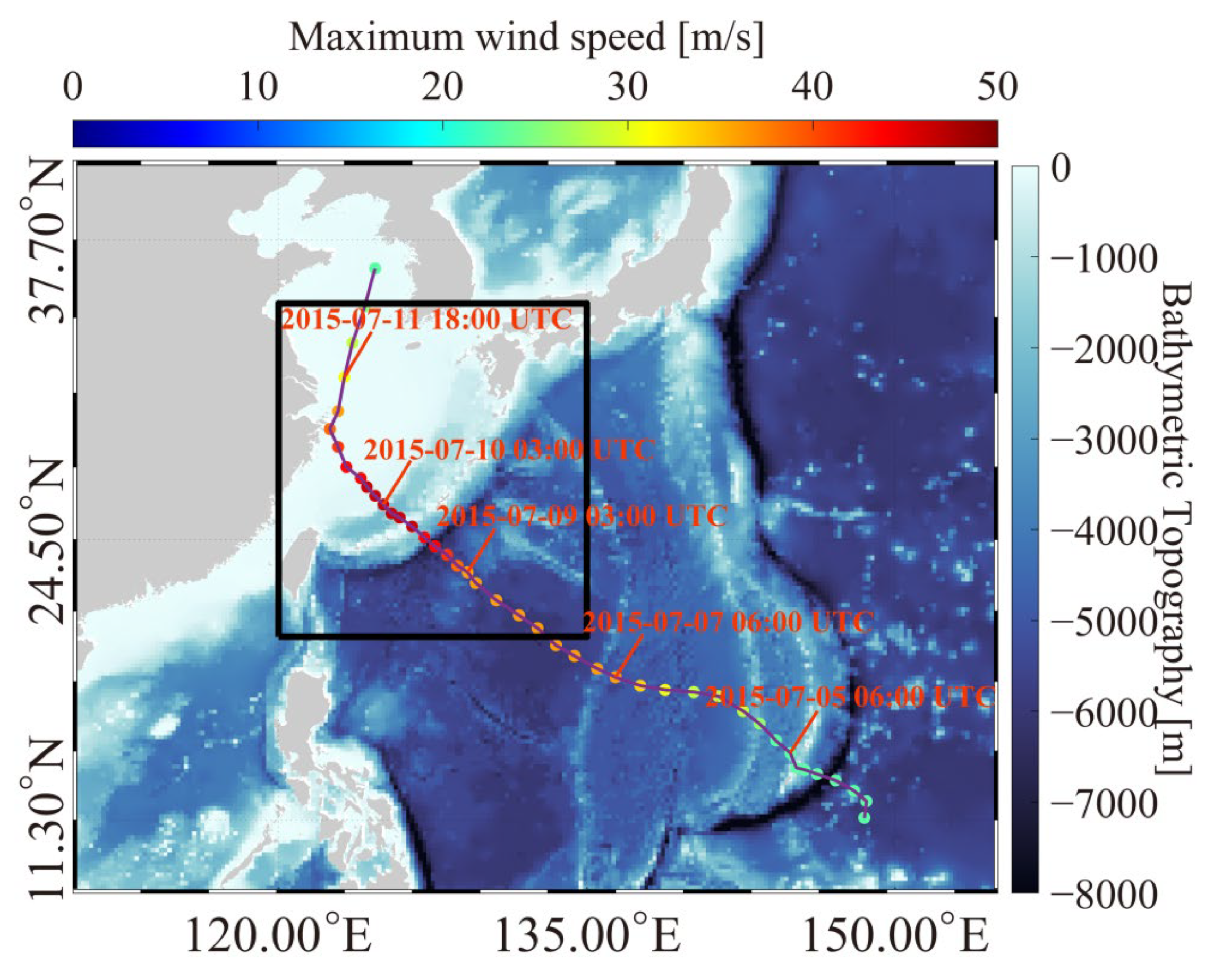
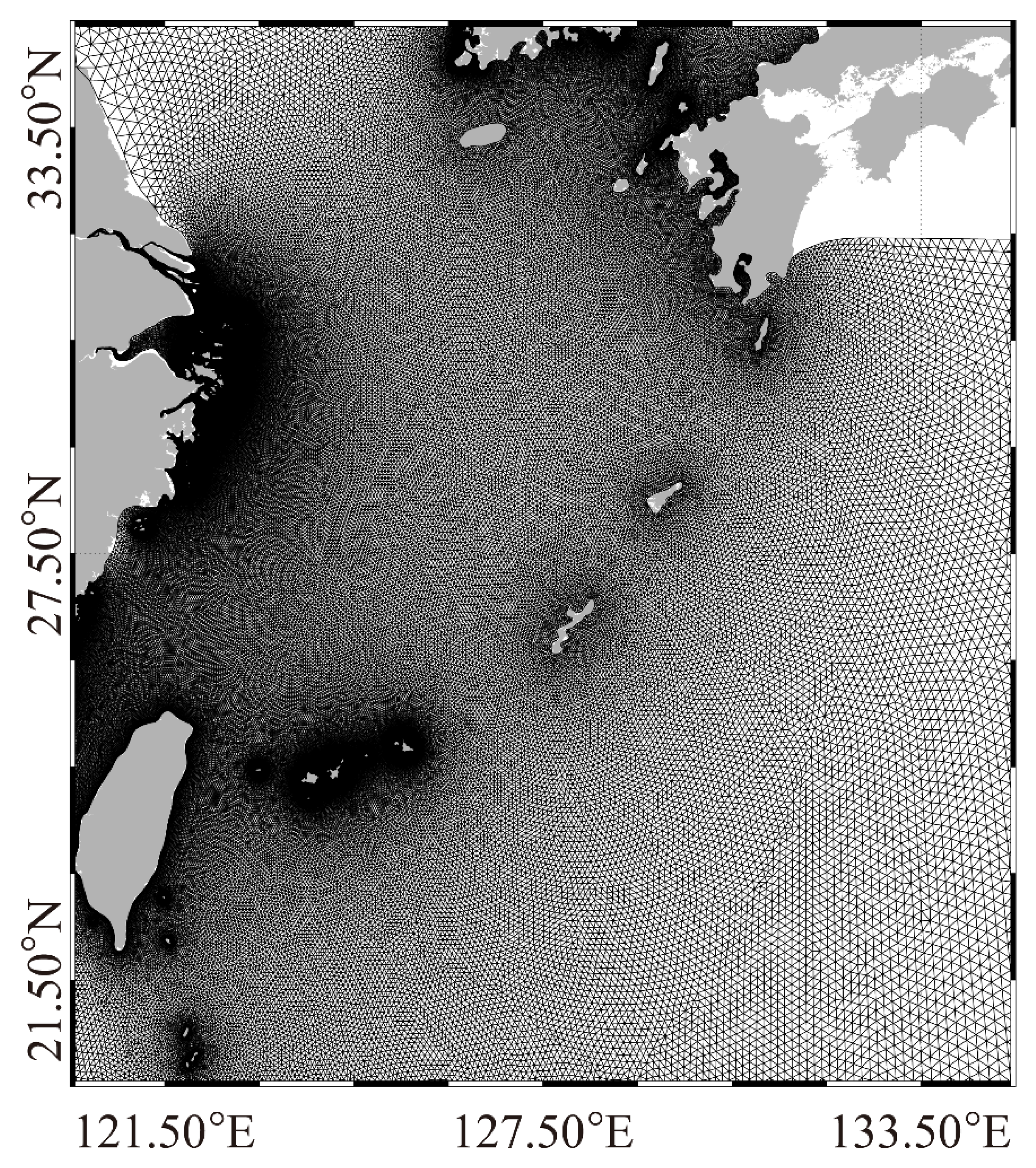
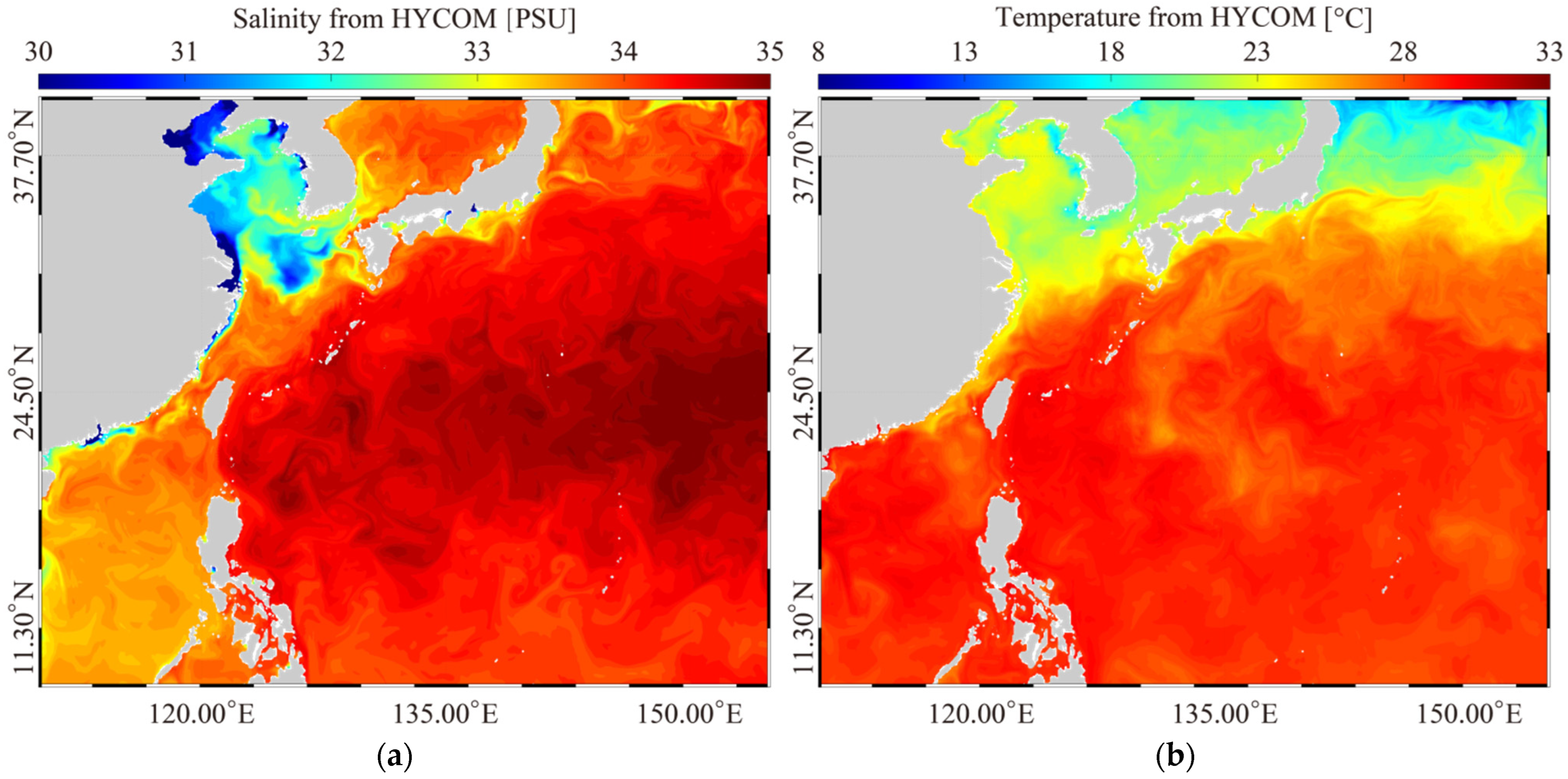
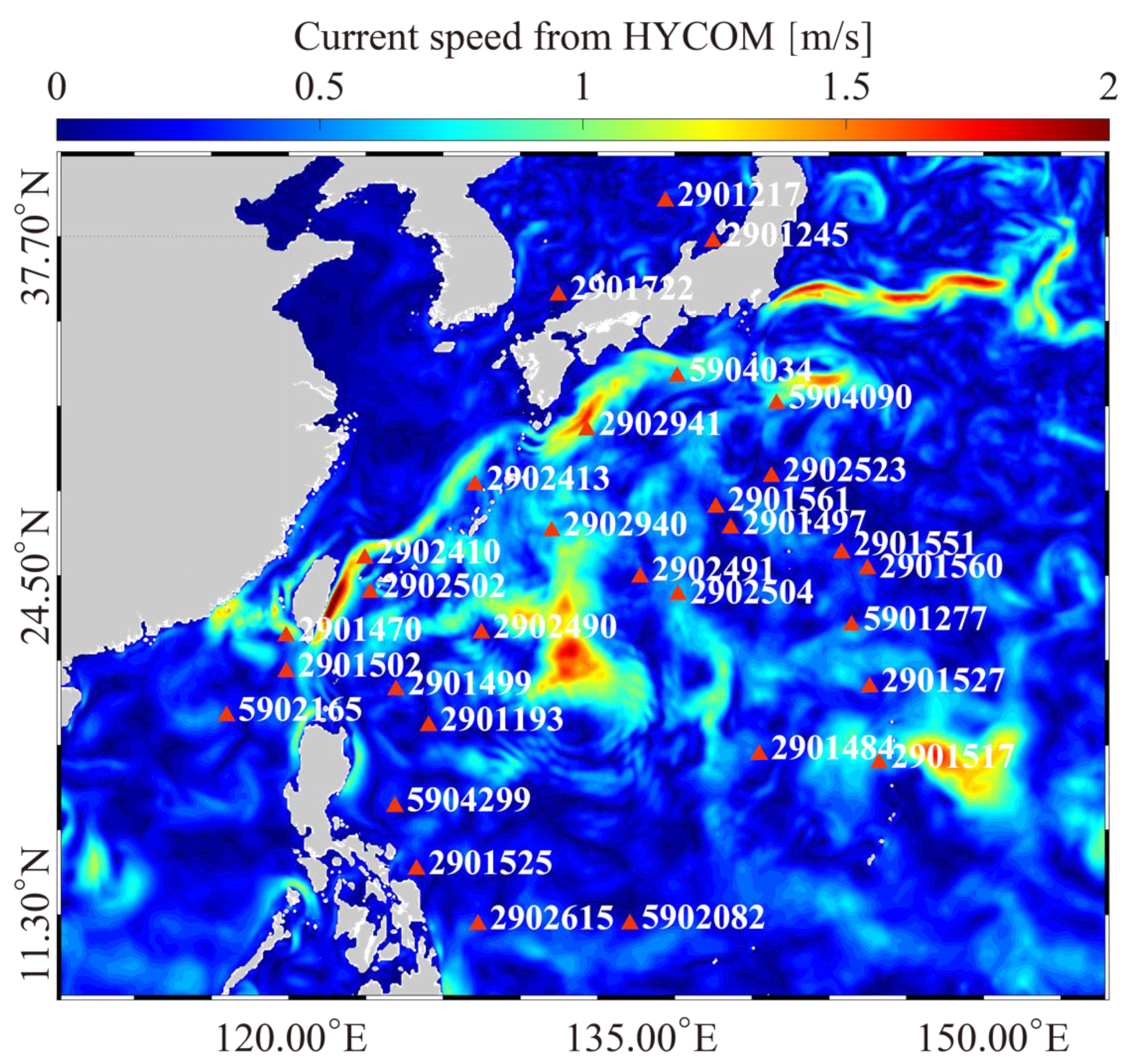

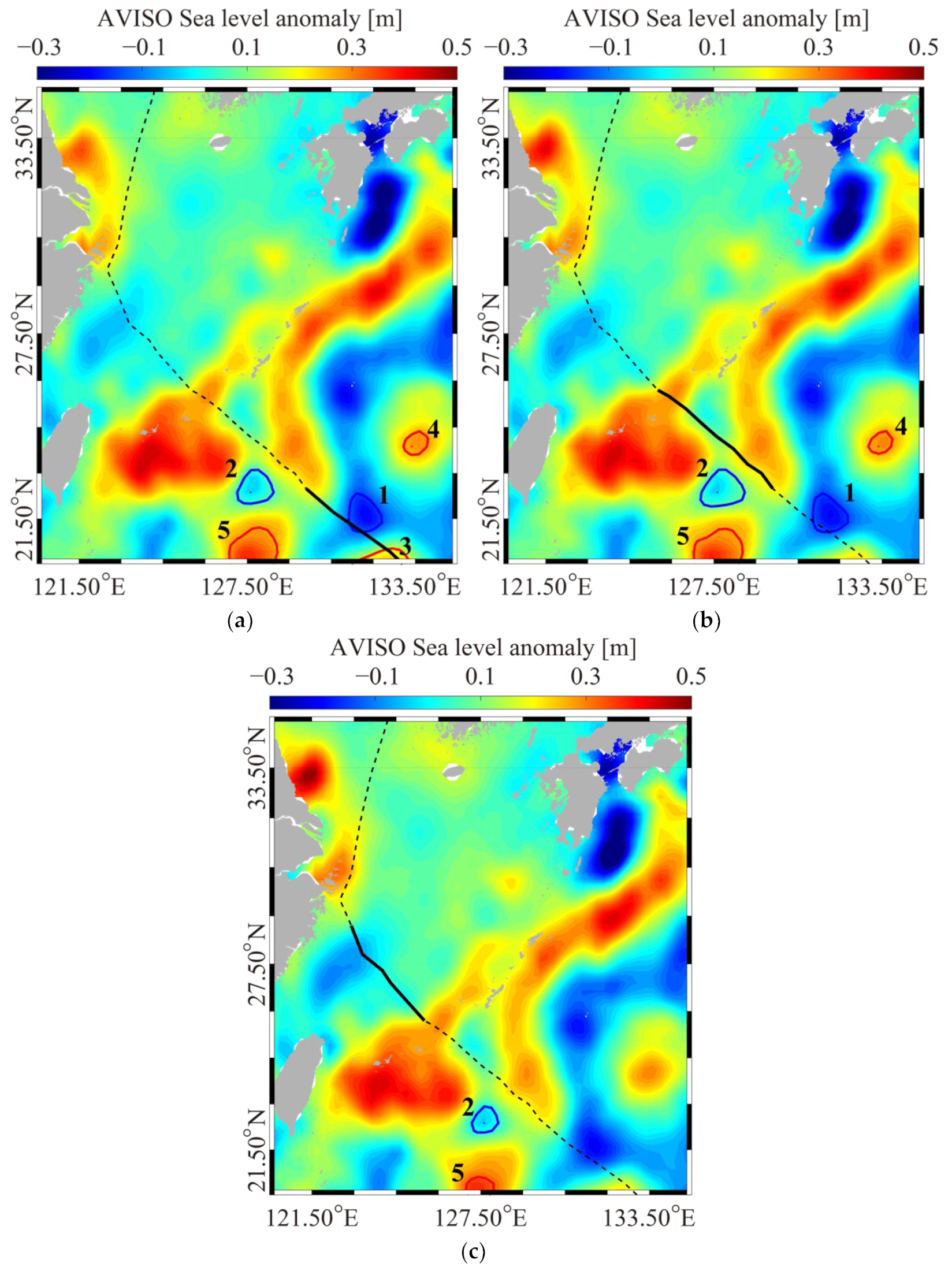
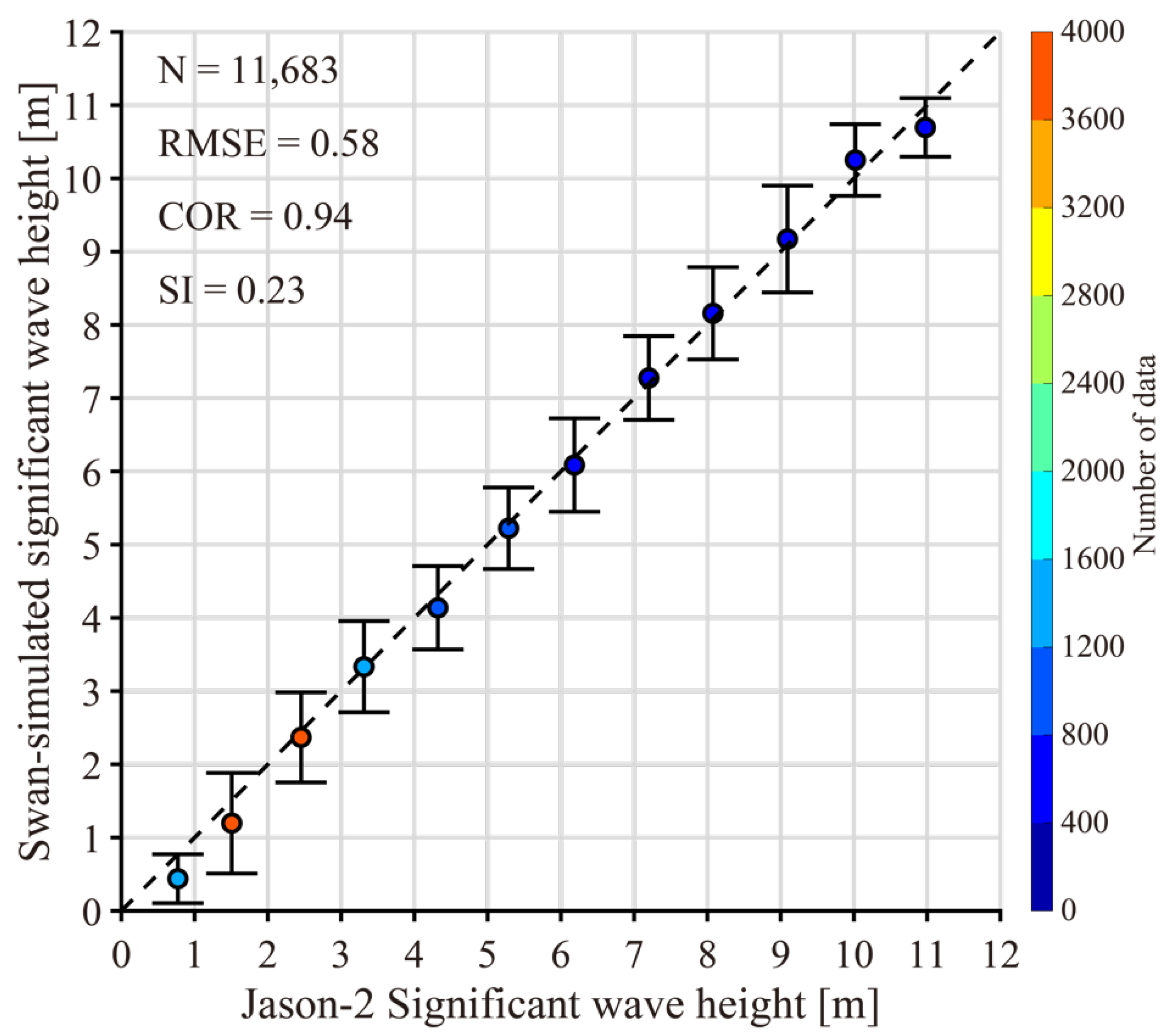

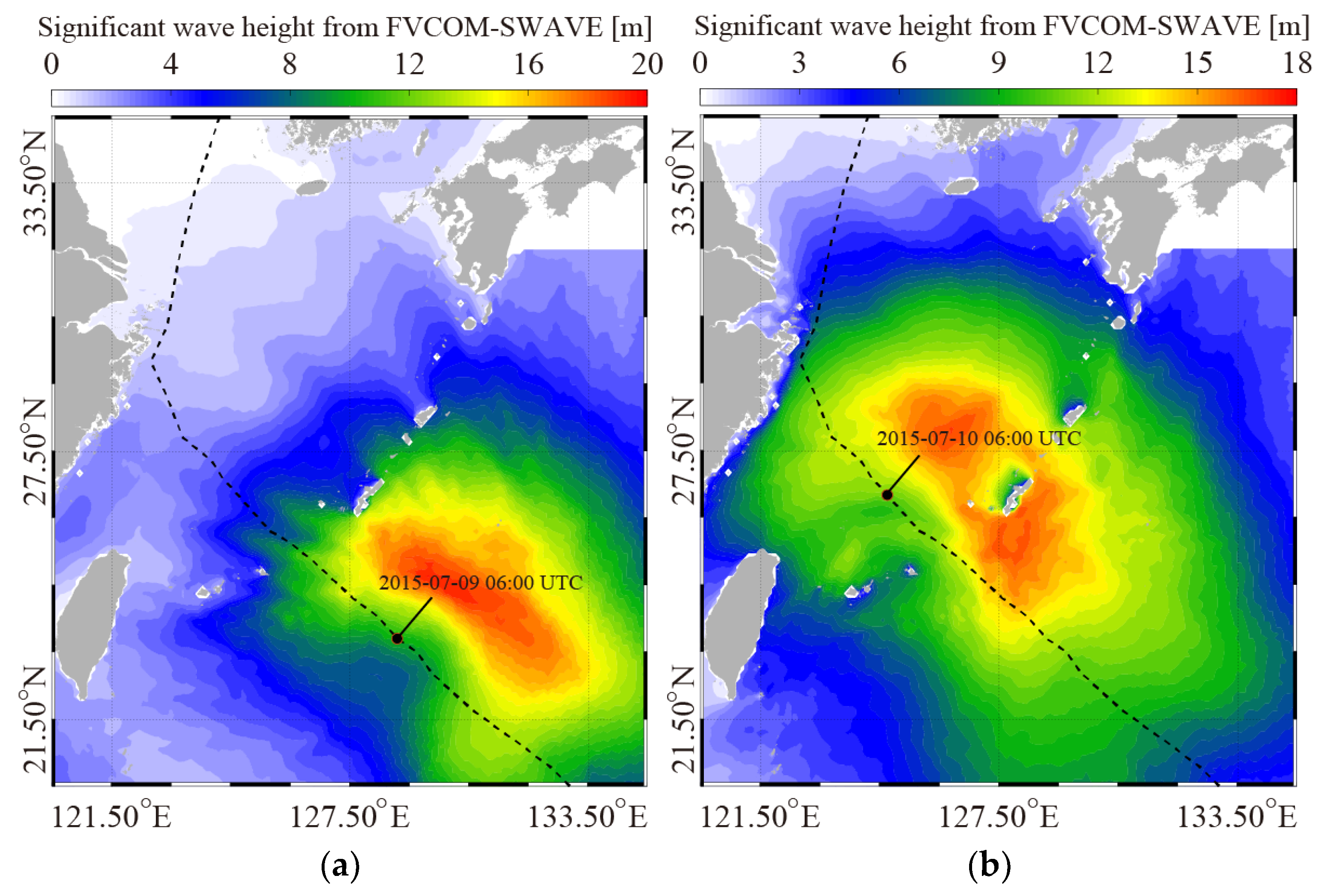
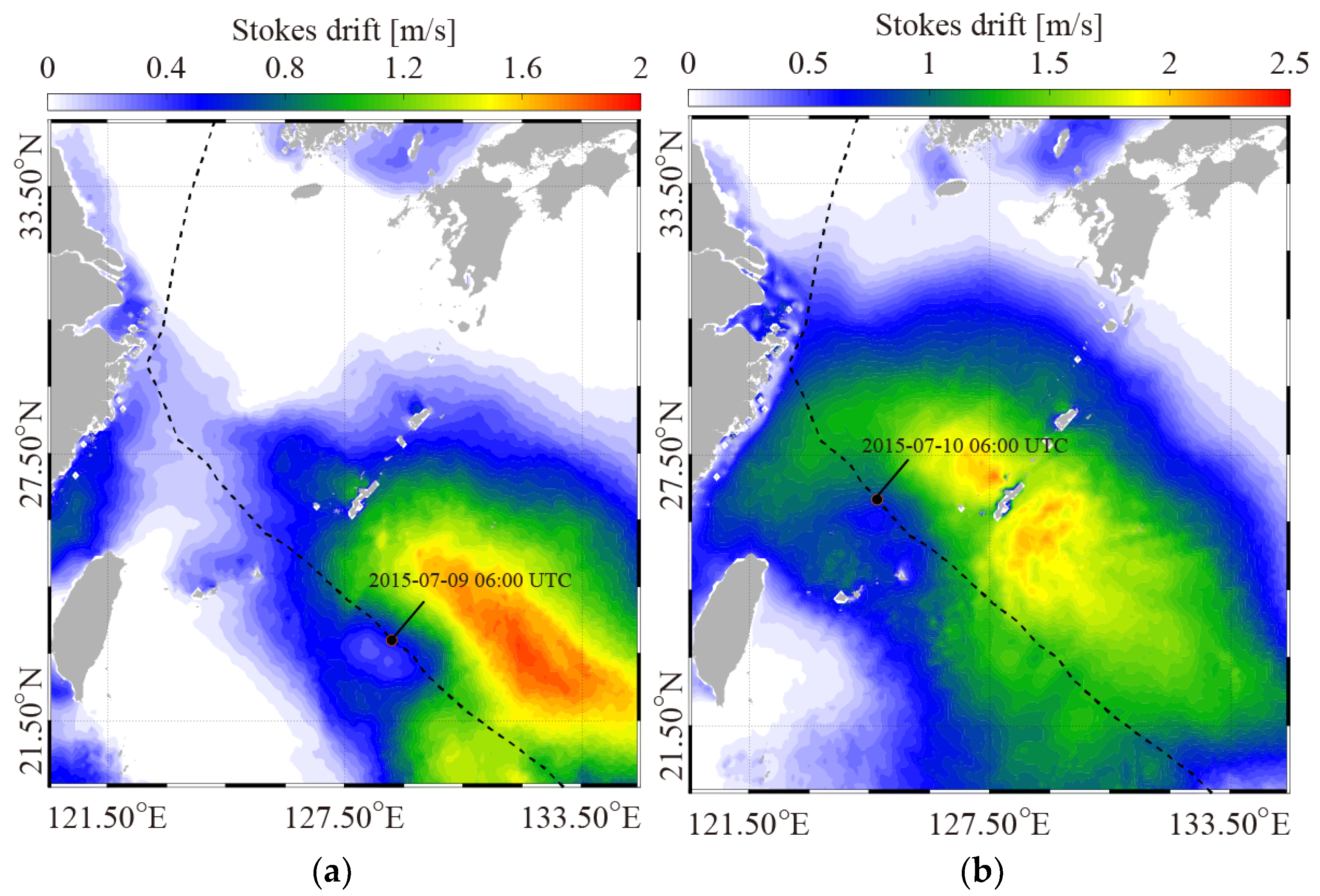
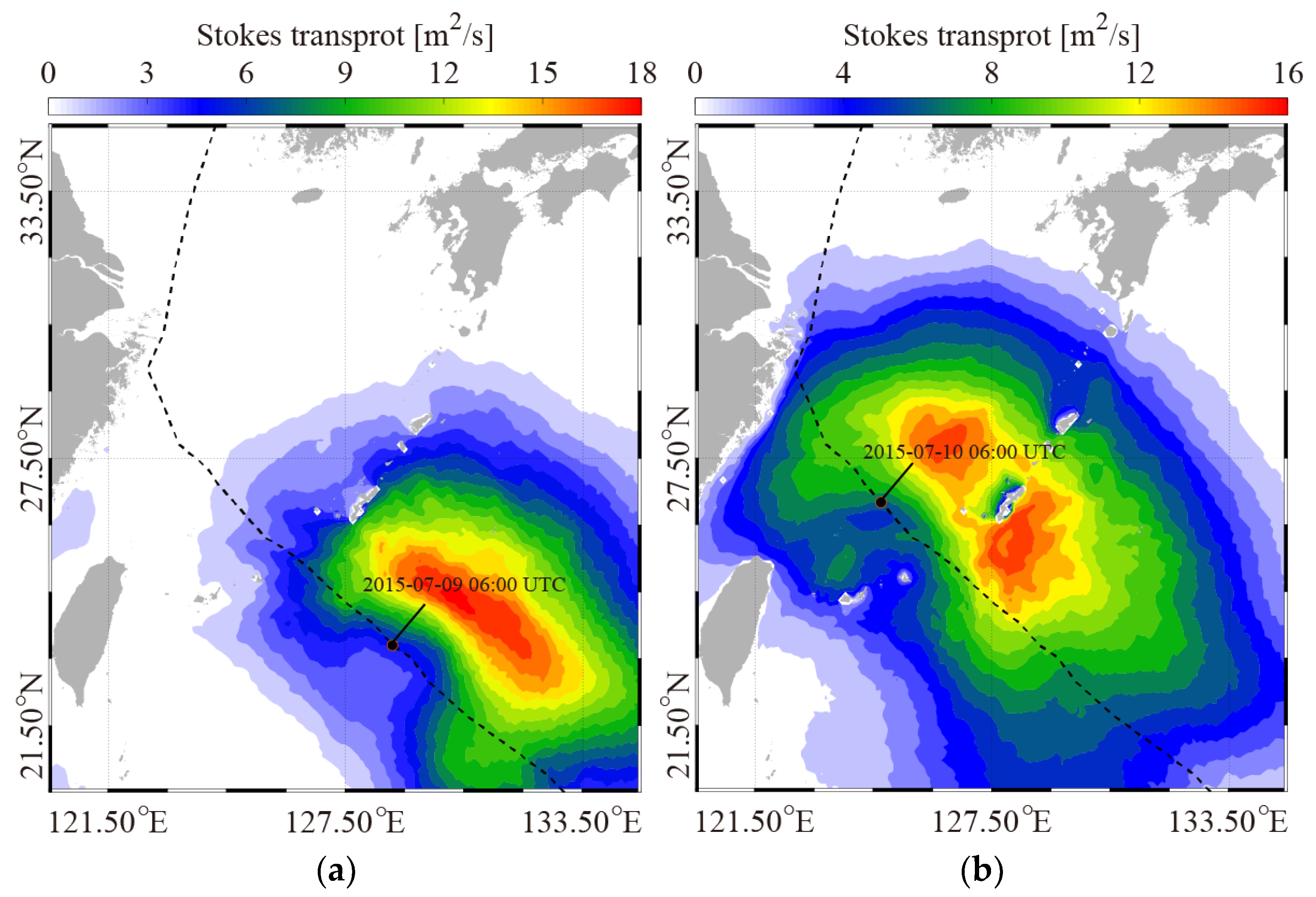
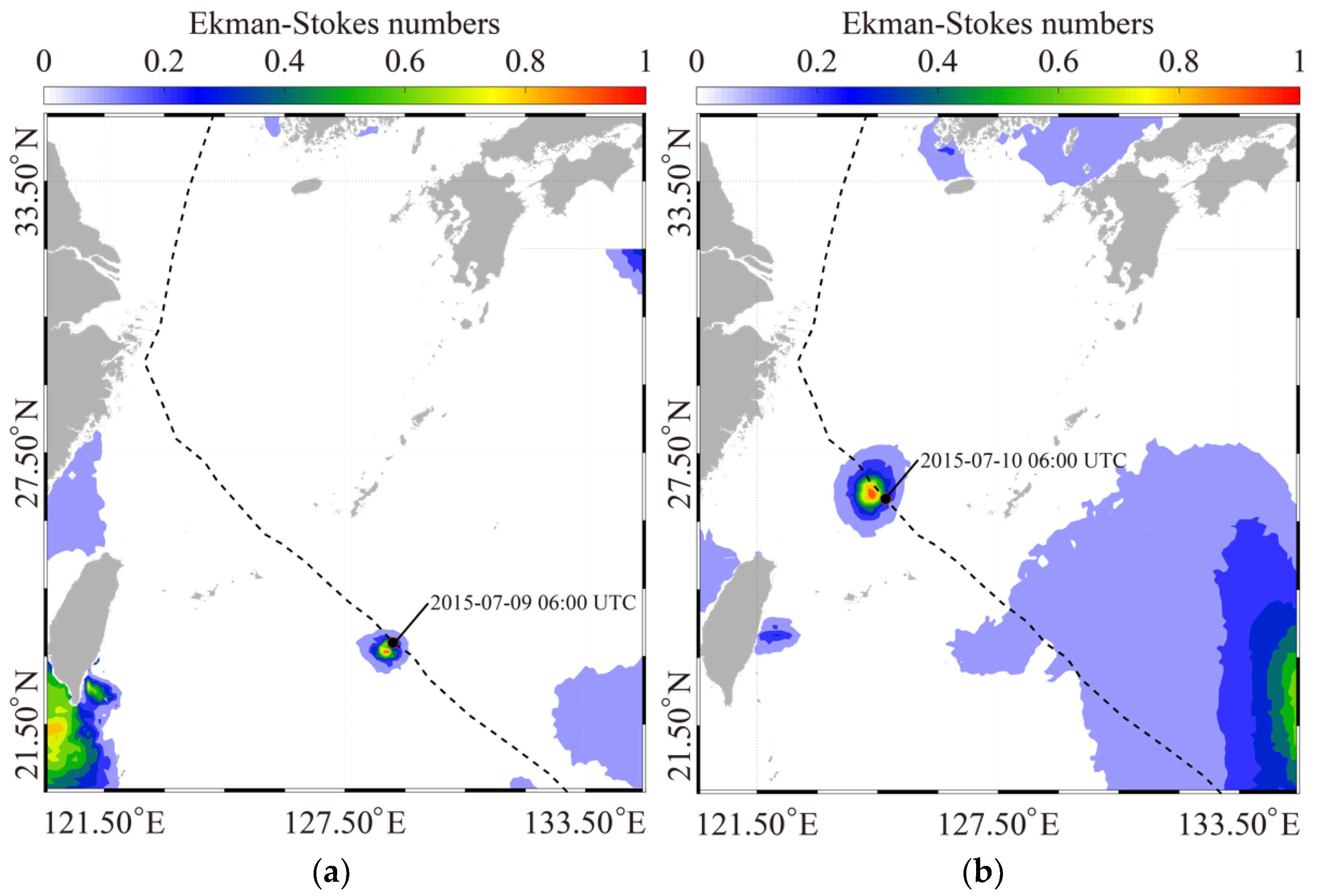

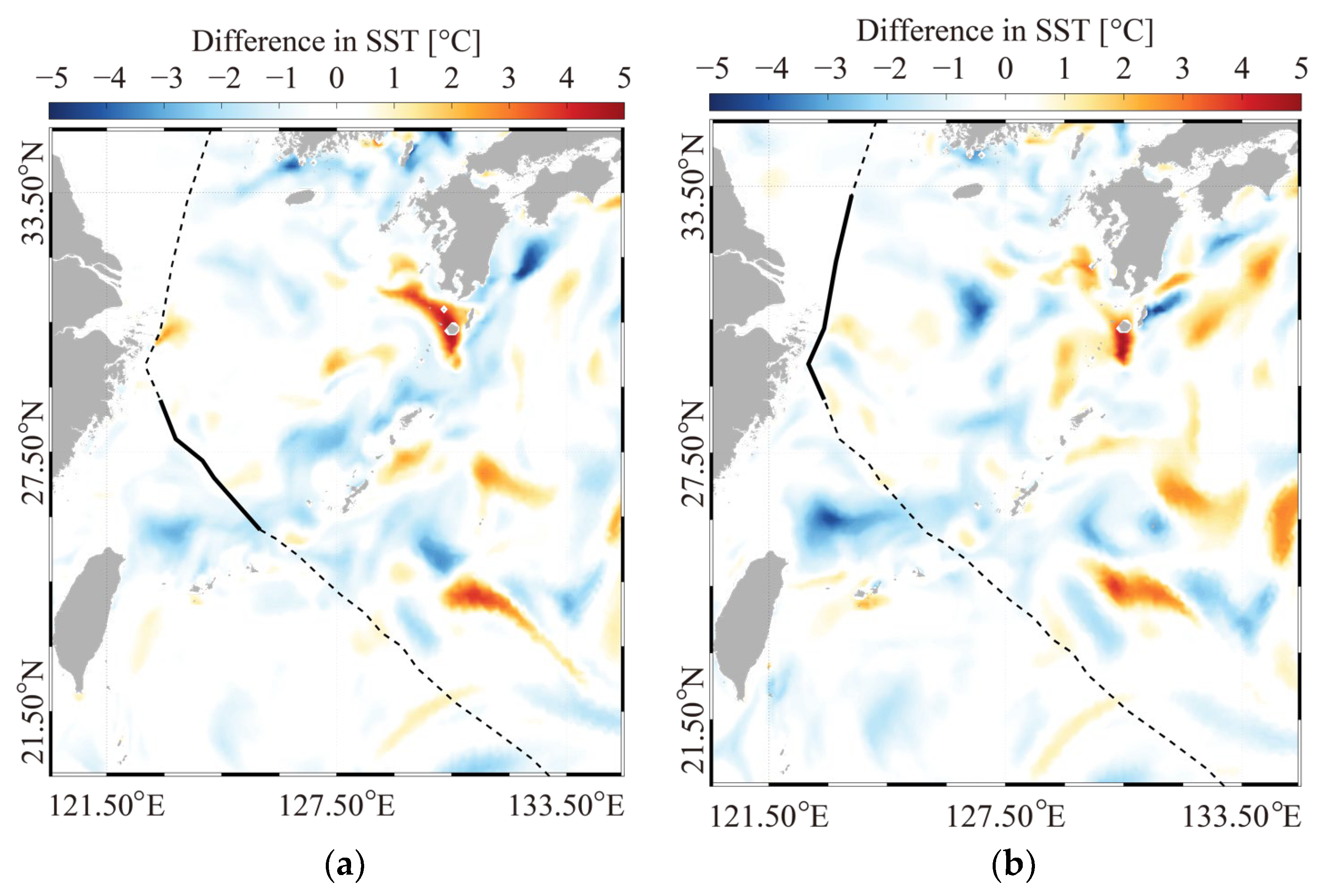

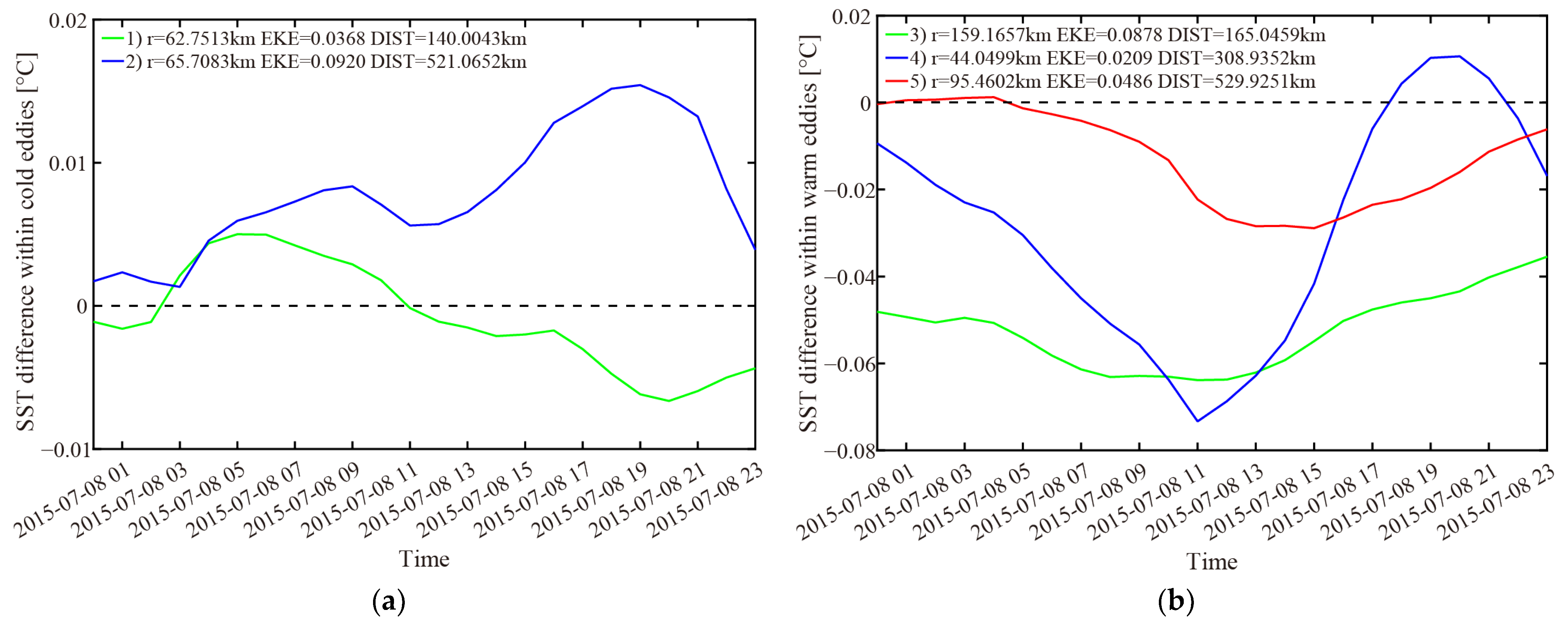
Disclaimer/Publisher’s Note: The statements, opinions and data contained in all publications are solely those of the individual author(s) and contributor(s) and not of MDPI and/or the editor(s). MDPI and/or the editor(s) disclaim responsibility for any injury to people or property resulting from any ideas, methods, instructions or products referred to in the content. |
© 2023 by the authors. Licensee MDPI, Basel, Switzerland. This article is an open access article distributed under the terms and conditions of the Creative Commons Attribution (CC BY) license (https://creativecommons.org/licenses/by/4.0/).
Share and Cite
Zhao, Z.; Shi, J.; Shao, W.; Yao, R.; Li, H. The Influence of Typhoon-Induced Wave on the Mesoscale Eddy. Atmosphere 2023, 14, 1804. https://doi.org/10.3390/atmos14121804
Zhao Z, Shi J, Shao W, Yao R, Li H. The Influence of Typhoon-Induced Wave on the Mesoscale Eddy. Atmosphere. 2023; 14(12):1804. https://doi.org/10.3390/atmos14121804
Chicago/Turabian StyleZhao, Zeqi, Jian Shi, Weizeng Shao, Ru Yao, and Huan Li. 2023. "The Influence of Typhoon-Induced Wave on the Mesoscale Eddy" Atmosphere 14, no. 12: 1804. https://doi.org/10.3390/atmos14121804




